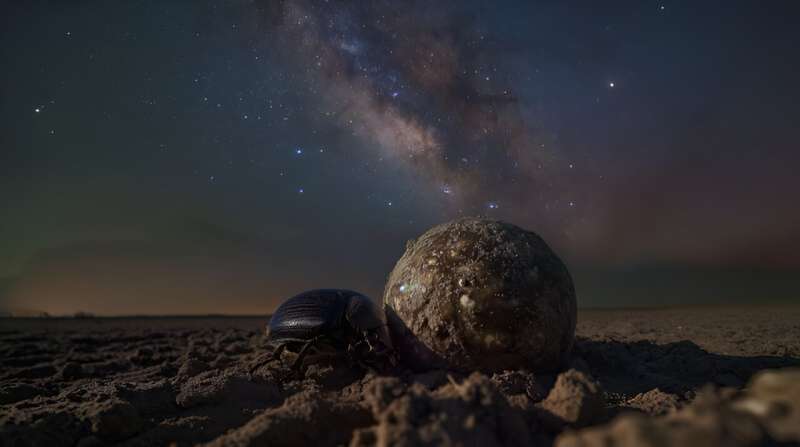This article has been reviewed according to Science X's editorial process and policies. Editors have highlighted the following attributes while ensuring the content's credibility:
fact-checked
peer-reviewed publication
trusted source
proofread
Engineers develop AI sensor based on dung beetle navigation

An insect species that evolved 130 million years ago is the inspiration for a new research study to improve navigation systems in drones, robots, and orbiting satellites.
The dung beetle is the first known species to use the Milky Way at night to navigate, focusing on the constellation of stars as a reference point to roll balls of dung in a straight line away from their competitors.
Swedish researchers made this discovery in 2013 and a decade later, Australian engineers are modeling the same technique used by the dung beetle to develop an AI sensor that can accurately measure the orientation of the Milky Way in low light.
University of South Australia remote sensing engineer Professor Javaan Chahl and his team of Ph.D. students have used computer vision to demonstrate that the large stripe of light that forms the Milky Way is not affected by motion blur, unlike individual stars.
"Nocturnal dung beetles move their head and body extensively when rolling balls of manure across a field, needing a fixed orientation point in the night sky to help them steer in a straight line," Chahl says. "Their tiny compound eyes make it difficult to distinguish individual stars, particularly while in motion, whereas the Milky Way is highly visible."
In a series of experiments using a camera mounted to the roof of a vehicle, the UniSA researchers captured images of the Milky Way while the vehicle was both stationary and moving. Using information from those images, they have developed a computer vision system that reliably measures the orientation of the Milky Way, which is the first step towards building a navigation system.
Their findings have been published in the journal Biomimetics.
Lead author UniSA Ph.D. candidate Yiting Tao says the orientation sensor could be a backup method to stabilize satellites and help drones and robots to navigate in low light, even when there is a lot of blur caused by movement and vibration.
"For the next step, I want to put the algorithm on a drone and allow it to control the aircraft in flight during the night," Tao says.
The sun helps many insects to navigate during the day, including wasps, dragonflies, honeybees, and desert ants. At night, the moon also provides a reference point for nocturnal insects, but it is not always visible, hence why dung beetles and some moths use the Milky Way for orientation.
Chahl says insect vision has long inspired engineers where navigation systems are concerned. Chahl explains, "Insects have been solving navigational problems for millions of years, including those that even the most advanced machines struggle with. And they've done it in a tiny little package. Their brains consist of tens of thousands of neurons compared to billions of neurons in humans, yet they still manage to find solutions from the natural world."
More information: Tao et al, Computer vision techniques demonstrate robust orientation measurement of the Milky Way despite image motion, Biomimetics (2024). DOI: 10.3390/biomimetics9070375.


















